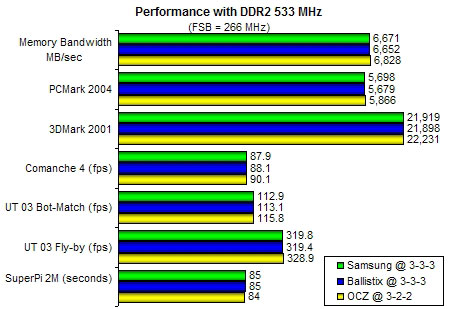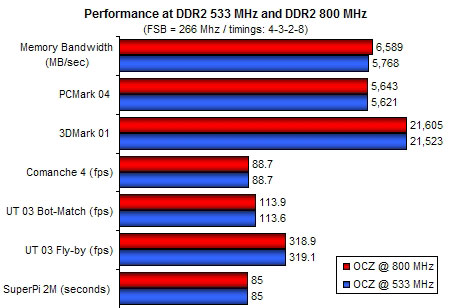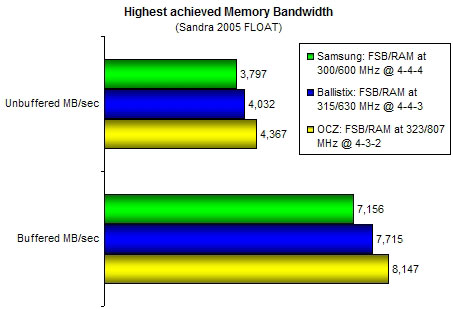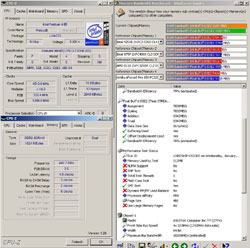|
|
|
|
|
OCZ PC2-6400 Platinum EB (DDR2 800MHz) |
|
Join the community - in the OCAU Forums!
|
Performance Comparison, Final Thoughts
Our first test is measuring system performance at default settings: The front-side bus is running at 4 x 266 MHz = 1060 MHz, the CPU at 14 x 266 MHz = 3.73 GHz, and the memory at 2 x 266 MHz = 533 MHz. This is the most efficient ratio between FSB and memory, because both of them run at the same frequency. All 3 products were tested at the best of their timing capabilities. That means we ran them with the most aggressive latency timings that were possible at 2.1 volt. At 533 MHz Ballistix and Samsung were in fact running at much tighter timings than their specified defaults. OCZ PC2-6400 did run at 533 MHz with 3-2-2. In all cases we kept the TRAS value at 8, because we found that this value has no impact on DDR2 bandwidth. We can see that there is a very small but consistently difference between the tested products at the given memory frequency and timings. They once more confirm the already well-known fact that aggressive memory latencies enhance system performance. OCZ PC2-6400 Platinum 2 running at tighter timings than Samsung and Ballistix is therefore the clear winner at 533 MHz.

As already mentioned OCZ PC2-6400 Platinum does run at 800 MHz with the timings of 4-3-2 and 2.1 volt. What impact on memory bandwidth and application performance can we expect when the memory frequency is running at 800 MHz? This is easy to find out with the Asus P4WD2, as the BIOS allows setting the memory frequency at 800 MHz whilst the front-side bus is running at the default speed of 266 MHz. To demonstrate the impact of 800 MHz on system performance we ran our tests twice: Once with a memory frequency of 533 MHz synchronously with FSB frequency and then again at asynchronous 800 MHz. In both cases the timings were identical 4-2-3. Memory bandwidth is visibly higher at 800 MHz compared with 533 MHz, but the impact on system performance when applications are running is almost zero. Why is this? At a memory frequency of 800 MHz the maximum data transfer rate between the memory and the memory controller is 12.8 GB/sec in dual channel mode. On the other hand the maximum transfer rate between the controller and the CPU is only 8.6 GB/sec, because the front-side bus is running with the default frequency of 266 MHz. No matter how fast the memory is running, the data transfer speed to the CPU can never exceed the bandwidth between the CPU and the memory controller. With other words: If the memory runs at a higher frequency than the front side-bus, the latter becomes a bottleneck. Running the memory asynchronously with a higher frequency than the FSB is therefore without merit for system performance.

The picture looks entirely different when FSB and memory frequency are increased simultaneously. In this case the front side and memory bus are balanced and the front-side bus does not become a bottleneck. The data transfer rate between memory and CPU is actually increasing and consequently system performance is going up. We are showing results for FBS 322 MHz and DDR2 644 MHz. 14 x 322 MHz = 4.50 GHz was the highest FSB frequency our watercooled 3.73 GHz + 955X would run all tests without becoming instable. Samsung PC2-4200 failed to run at 644 MHz. Ballistix did run all benchmarks at 644 MHz with latency timings of 5-4-4. OCZ PC2-6400 Platinum completed all tests at 644 MHz with timings of 4-3-2. The results show that application performance is between 10% and 15% better at DDR2 644 MHz than at 266 MHz. The performance boost is of course only to a small extent the result of the faster running memory. The far bigger part has to be attributed to the higher CPU running at 14 x 322 MHz = 4.50 GHz instead of 14 x 266 MHz = 3.73 GHz. However a prerequisite to achieve such substantially better system performance is memory like OCZ PC2-6400 that is stable and with relatively tight timings running at a ratio of 1:1 with the FSB frequency. As we have demonstrated PCZ PC2-6400 Platinum would run far higher than 644 MHz, but our Pentium 4 3.73 GHz EE had reached its water-cooled limit at 4.50 GHz. In order to fully exploit the OCZ PC2 6400 frequency head room we would have to run our 3.73 GHz system at up to 14 x 400 GHz = 5.6 GHz which is of course impossible with water cooling - if it is possible at all.

We finally tried to figure out the maximum memory frequency for each of the 3 DDR2 products. For this purpose we tried various combinations of FSB to memory ratios and timings. Ballistix and Samsung achieved their best bandwidth with FSB and memory running at the same frequency; that was DDR2 630 MHz @ 4-4-3 for Ballistix and DDR2 600 @ 4-4-4 for Samsung. Both would run at higher frequencies, this however only with less aggressive timings and consequently lower bandwidth.

The shining star is once again OCZ PC2-6400 Platinum. The best bandwidth we could achieve with this memory was an eye-popping 8,150 MB/sec at FSB 323 MHz and the memory running at DDR2 807 MHz with 4-3-2 timings.

FINAL THOUGHTS:
The tested OCZ PC2-6400 Platinum dual channel kit performed as advertised and did run at 800 MHz with 4-3-2 timings. But it did even better than this: With 5-4-3 timings it went up to 905 MHz. The maximum buffered bandwidth we could achieve with this DDR2 product was 8,150 MB/sec. As a matter of fact: OCZ PC2-6400 Platinum was exceeding the limits of our watercooled test system. It would have taken at least phase-change CPU cooling to bring the FSB frequency up to the maximum possible memory frequency of 800 MHz to fully exploit the capabilities of this DDR2 product. For users who run their DDR2 in line with the 915/925 or 945/955 chipset default system-bus frequency itís important to know that OCZ PC2-6400 Platinum runs at 533 MHz with 3-2-2 timings. These are the most aggressive DDR2 timings currently available. We doubt that there is a better performing DDR2 memory in the market. OCZ PC2-6400 Platinum is an enthusiast product and for this user group we do recommend it. Unfortunately it carries a hefty price tag of around 430 US$. Those who are not looking for the last bit of performance should have a look at OCZ PC2-6400 Gold. It runs as well at 800 MHz, albeit at less aggressive timings of 5-5-5, and the 1 GB kit comes for a more moderate price of 300 US$.
|
|
Advertisement:
All original content copyright James Rolfe.
All rights reserved. No reproduction allowed without written permission.
Interested in advertising on OCAU? Contact us for info.
|

|


